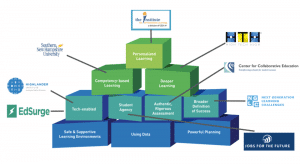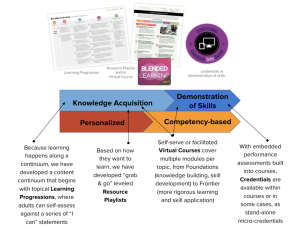Building Field Readiness & Capacity to Personalize
CompetencyWorks Blog

One of the recommendations that came forth from the National Summit on K-12 Competency-Based Education (the paper with all the recommendations is forthcoming) is that field organizations begin to collaborate at higher levels. There is so much knowledge being produced by schools and districts — we need to create mechanisms to make it easier for educators to access and make meaning of it for their own work. Bravo to 2 Revolutions and their partners in doing exactly what the field needs, exactly at the right time. You can read the original blog at 2 Revs website.
— Chris Sturgis
We are excited to announce that 2Rev — with generous support from a national funder, and through deep collaboration with a range of leading organizations — is spearheading a large-scale effort to make available free, high-quality learning content to help educators gain the knowledge and skills they need to personalize learning for students.
The move toward more personalized, learner-centered approaches is part of the solution we’re all striving toward for kids and families. Unfortunately, most of the field currently lacks readiness and capacity to do the complex work of transformation needed to realize these personalized learning models and systems. The absence of consistent, high-quality content and engagement strategies makes it more difficult and inefficient for states, districts and providers to support efforts to increase field readiness and capacity. Working together with partners, we can help address this gap.
Key Partners & the Content We Are Building Together
We’ve just begun this two-year initiative, so we’re not going to try to squeeze all the details into this first post. Today we’re sharing an outline of what we’re planning by posing a set of questions to unpack the logic.
What do we mean by “content”? There are many useful individual learning objects out there when it comes to how to personalize learning — ranging from blog posts and how-to videos, to white papers, research reports and micro-credentials. There also are dozens of platforms and websites where you can find this content. Unfortunately, these platforms are disconnected and there’s no guarantee the content you find will be helpful or high-quality (even after all that searching!).
In our experience with InspirED, our social learning platform, we noticed users responded well to the content in our library of resources when we curated resources for them, rather than when they had to search for resources on their own. This observation sparked more intentional curation and design, which then grew into our team deliberately building scaffolded adult learning experiences anchored to topical learning progressions.
We always want our users to ask and be able to answer through these progressions: Where am I as an adult learner, and where am I trying to go? Key resources like playlists and course modules hang off these progressions for each topic (see image below), making it more possible to meet the unique needs of each adult learner.
2Rev Instructional Design Methodology
Does this sound familiar, like personalized learning for students? It sure does. The power of content has limitations, especially if it’s not meeting the needs of adult learners. Through deep work over the last few years in some of our more intensive partnerships — like our work in Dallas with the Personalized Learning Initiative; in Washington D.C. in partnership with Citybridge Education; in New Hampshire in partnership with the New Hampshire Department of Education and the New Hampshire Learning Initiative around Essential Skills and Dispositions; and in Virginia in partnership with Loudoun County Public Schools to support performance-based assessment — we’ve witnessed the power of modeling personalized learning for educators. The graphic above unpacks the instructional design logic. See this previous blog post where we go a bit deeper into our approach.
So why not bowl alone? One lesson that’s painfully clear from the graveyard of previous efforts is that well-intentioned, solo efforts are challenging…and rarely as successful as we all need them to be. In this effort, we have elected to partner deeply with a set of world-class organizations who are already reshaping the field — including the Center for Collaborative Education, EdSurge, Highlander Institute, High Tech High, Institute for Personalized Learning, Jobs for the Future, Next Generation Learning Challenges and Southern New Hampshire University. (We’re also finalizing conversations with a few more phenomenal partners who we’ll announce in the coming weeks!) Each of these organizations bring their different perspectives and strengths, as well as their collective reach. We will all work together to build, refine and create new content.
If we build it, will they come? And more importantly, will they use it to grow their practice? We all know content alone is not enough. If you build it, educators will not necessarily come. Therefore, our strategy also includes more than a dozen additional partners who will help us “activate” the content by distributing through their networks and committing to leverage directly in their work. Our goal is a big tent that includes partner states, districts, providers and other relevant organizations all committed to accelerating the transition to the future for kids by building educator capacity. Instead of developing the content themselves from scratch, they can adapt free, high-quality content to respond to the needs of their local context.
Where and when can I get it? All of this content will be available for free on InspirED…but that is by no means the only place. This is not 1997, or even 2007. The platform is no longer the point and we’re not trying to hold anyone captive within one specific online learning environment. Instead, we’re excited to be part of the solution. For this to work, we need collaboratively-created high-quality content to be as broadly available as possible. Therefore, all of the content can be accessed through InspirED and downloaded, if desired, for use elsewhere. For schools, districts, states and other organizations, this rich set of resources will be available beginning in January 2018. If interested, we and our core partners can also support facilitated learning experiences or credentials (e.g., graduate credits or certification “stacks”).
What are we hoping to learn? We can all learn so many things from this effort. We have assembled a rockstar advisory board of leaders from our core content partners – as well as from Digital Promise, Learning Forward and The Learning Accelerator – who will help us learn from user activity, behavior, learning and performance. Some of the questions we’re asking ourselves include:
- How do systems make use of free/open high quality resources to accelerate the transition to personalized learning? How much is the content catalytic to broader change?
- How do providers leverage these resources to support their efforts? How willing are providers to leverage other branded materials in service of their work and is that a deterrent?
- What can we learn about individual educator motivations and preferences for content to better meet their needs? How does increased access/exposure to content lead to measurable increases in knowledge and skill? To changes in practice? To student outcomes?
- What are the limitations of the content itself and what does demand look like for deeper facilitation, accreditation or implementation supports?
- To what extent does availability of free/open content build increased demand for additional content, tools and other resources?
See also:
- 4 Ways We Can Fund Personalized Learning to Create More Equitable Schools
- Getting Closer to the Future of Teacher Learning
- The Future of Teacher Learning
Adam has spent over two decades catalyzing change through the design and launch of social enterprises across the education and community development sectors. He started 2Revolutions to feed this love, and to reinforce a belief that two critical levers we can pull are the birth and scaling of innovative ventures as a way to affect real change. At 2Rev, Adam is able to feed his love of both systems change and practice innovation.

